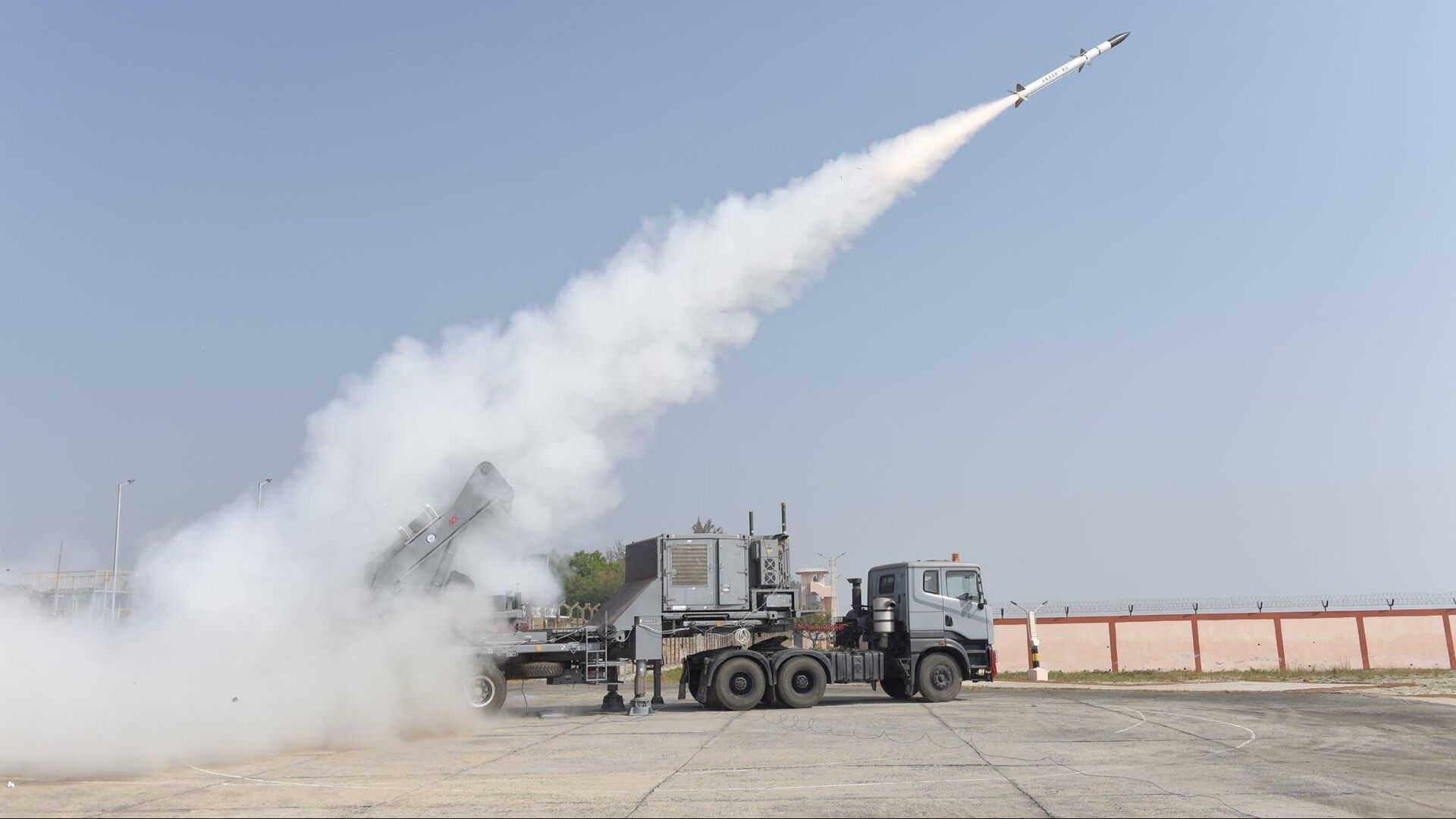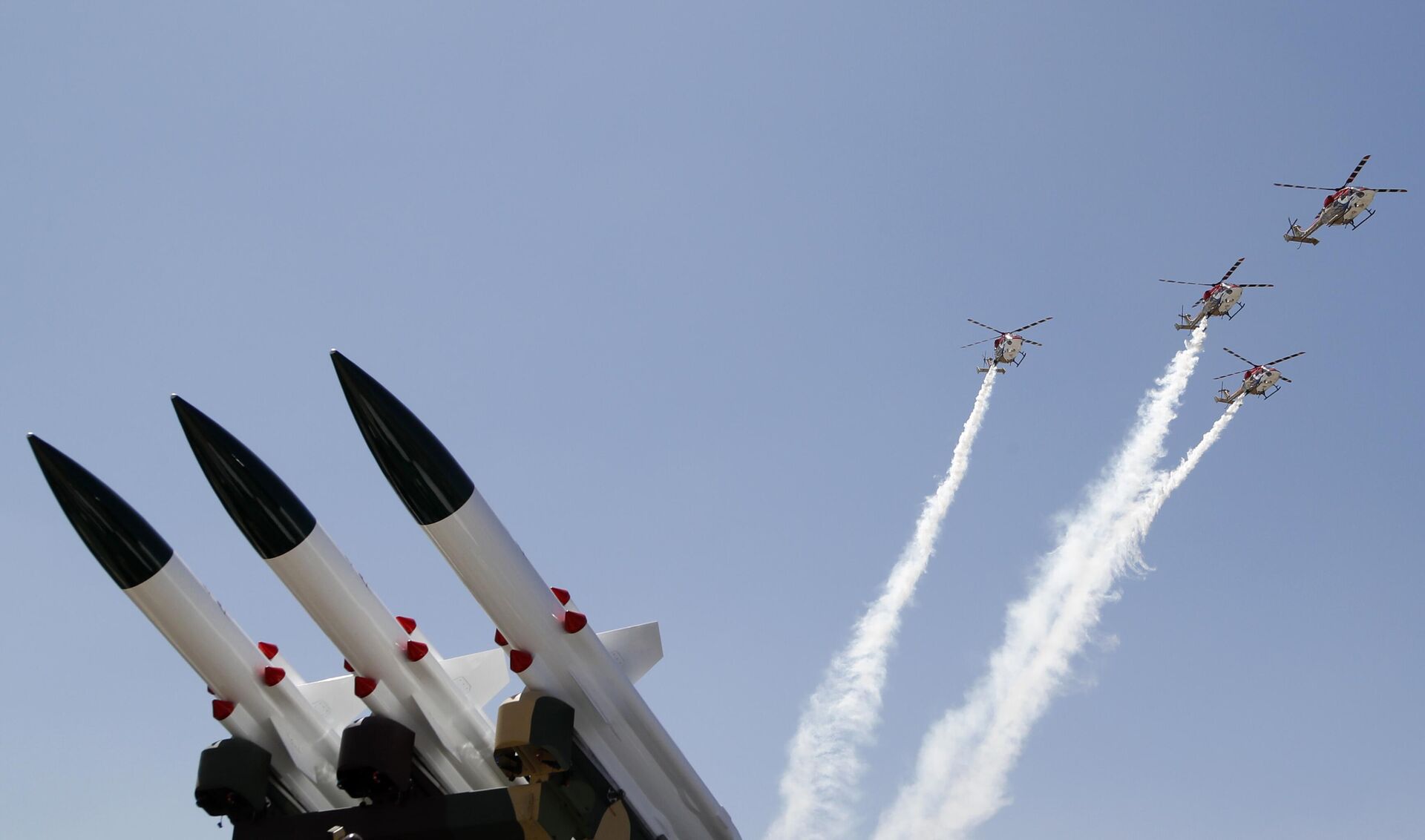https://sputniknews.in/20240115/indias-new-generation-akash-interceptor-missile-ready-for-user-trials-6208260.html
India's New Generation Akash Interceptor Missile Ready for User Trials
India's New Generation Akash Interceptor Missile Ready for User Trials
Sputnik India
DRDO successfully tested the Akash-NG interceptor missile off Odisha's coast. This 4th trial, featuring advanced targeting and mobility, reinforces India's air defense capabilities against modern aerial threats.
2024-01-15T14:56+0530
2024-01-15T14:56+0530
2024-02-01T15:13+0530
defenсe news
india
odisha
russia
nato
indian air force (iaf)
mod russia
https://cdn1.img.sputniknews.in/img/07e8/01/0c/6174833_0:212:2048:1364_1920x0_80_0_0_827878cc983ecb621cc7aa4bc49b992e.jpg
On January 12, 2024, the DRDO conducted a successful flight-test of the New Generation Akash (Akash-NG) interceptor missile from the Integrated Test Range (ITR), Chandipur off the coast of Odisha at 10:30 IST. The test was the 4th known test of the Akash NG missile, which was maiden tested on January 25, 2021.According to a Press Information Bureau (PIB) release, as part of the test, the missile engaged and destroyed a high-speed unmanned aerial target at very low altitude. The test validated the functioning of the complete weapon system consisting of the missile with indigenously developed Radio Frequency Seeker, Launcher, Multi-Function Radar and Command, Control & Communication system.Akash NG OverviewAkash-NG is a new generation interceptor Missile developed for the Akash AD (Air Defence) System. The earlier Akash interceptor, based on the Soviet era SA-6 (NATO codename Gainful) missile, used ramjet propulsion sustainer and TVM (Track Via Missile) Seeker. A TVM seeker combines SARH (Semi Active Radar Homing) and command guidance. TVM homing is jam proof but its accuracy drops with target range.In contrast, the Akash NG uses a dual pulse rocket motor and an active seeker. The tracking ability of an active seeker does not degrade with target range but the seeker is prone to jamming and spoofing. Ram jet or dual pulse motors provide good end game manoeuvrability.The Akash NG was designed and developed by the DRDO and manufactured by Pune-based Electropneumatics and Hydraulics (India) Pvt Ltd (EHPL) for the Indian Air Force to facilitate interception of high manoeuvring, low RCS aerial threats.The active seeker of the missile is being manufactured by Bharat Electronics Limited (BEL).Akash-NG CapabilitiesPast TestsThe maiden test of the missile on January 25, 2021 used an electronic target and validated the ability of the missile to engage a hard manoeuvring target.The missile was tested for the second time on July 21, 2021, once again without its active seeker against an electronic target.In a follow-up test on July 25, 2021 the missile fitted with an active seer successfully intercepted a high-speed unmanned aerial target.The test validated the functioning of the complete weapon system consisting of the RF Seeker, Launcher, Multi-Function Radar and Command, Control & Communication system.Test on January 12On January 12, the missile was tested using a different configuration TEL (Transporter, Erector & Launcher).It's likely that DRDO decision to revert to the use of a trailer is a minor setback as it will adversely affect the mobility of the system and may increase the time taken to transition to ready to fire mode. It could also complicate air transportation.ConclusionThe MoD press release on the January 12 test stated that the success of the flight test has paved the way for user trials.Russia's special military operation (SMO) in Ukraine has shown that missile based AD is critical to the success of military operation over land or sea.Proliferation of relatively inexpensive drones that need to be destroyed using much more expensive AD missiles has emphasised the need for a nation to locally produce AD missiles at low cost and in large numbers. As such, the integration of the Akash-NG interceptor into the Akash AD system will address a big concern of our Armed Forces and comes at the right time.
https://sputniknews.in/20240112/drdo-successfully-tests-new-generation-akash-missile-in-flight-6174149.html
india
odisha
russia
Sputnik India
feedback.hindi@sputniknews.com
+74956456601
MIA „Rossiya Segodnya“
2024
News
en_IN
Sputnik India
feedback.hindi@sputniknews.com
+74956456601
MIA „Rossiya Segodnya“
Sputnik India
feedback.hindi@sputniknews.com
+74956456601
MIA „Rossiya Segodnya“
january 12, 2024, drdo, flight-test, new generation akash, akash-ng, interceptor missile, integrated test range (itr), chandipur, odisha, 4th test, unmanned aerial target, weapon system, radio frequency seeker, launcher, multi-function radar, command, control & communication system, akash ad (air defence) system, soviet era sa-6, nato codename gainful, ramjet propulsion, tvm (track via missile) seeker, sarh (semi active radar homing), command guidance, dual pulse rocket motor, active seeker, jamming, spoofing, indian air force, low rcs, mobility, field storage, wheeled vehicle/trailer, missile canisters, electropneumatics and hydraulics (india) pvt ltd (ehpl), bharat electronics limited (bel), multiple targets, intercept range, active homing, fire and forget, elevation, azimuth, reloading time, reaction time, target acquisition, firing rate, transportation mode, electronic target, hard manoeuvring target, transporter erector & launcher (tel), control cabin, power generation, user trials, russia's special military operation (smo), ukraine, military operation, drones, ad missiles, local production, akash ad system, armed forces.
january 12, 2024, drdo, flight-test, new generation akash, akash-ng, interceptor missile, integrated test range (itr), chandipur, odisha, 4th test, unmanned aerial target, weapon system, radio frequency seeker, launcher, multi-function radar, command, control & communication system, akash ad (air defence) system, soviet era sa-6, nato codename gainful, ramjet propulsion, tvm (track via missile) seeker, sarh (semi active radar homing), command guidance, dual pulse rocket motor, active seeker, jamming, spoofing, indian air force, low rcs, mobility, field storage, wheeled vehicle/trailer, missile canisters, electropneumatics and hydraulics (india) pvt ltd (ehpl), bharat electronics limited (bel), multiple targets, intercept range, active homing, fire and forget, elevation, azimuth, reloading time, reaction time, target acquisition, firing rate, transportation mode, electronic target, hard manoeuvring target, transporter erector & launcher (tel), control cabin, power generation, user trials, russia's special military operation (smo), ukraine, military operation, drones, ad missiles, local production, akash ad system, armed forces.
India's New Generation Akash Interceptor Missile Ready for User Trials
14:56 15.01.2024 (Updated: 15:13 01.02.2024) DRDO successfully tested the Akash-NG interceptor missile off Odisha's coast. This 4th trial, featuring advanced targeting and mobility, reinforces India's air defense capabilities against modern aerial threats.
On January 12, 2024, the DRDO conducted a
successful flight-test of the
New Generation Akash (Akash-NG) interceptor missile from the Integrated Test Range (ITR), Chandipur off the coast of Odisha at 10:30 IST. The test was the
4th known test of the Akash NG missile, which was maiden tested on January 25, 2021.
According to a Press Information Bureau (PIB) release, as part of the test, the missile engaged and destroyed a high-speed unmanned aerial target
at very low altitude. The test validated the functioning of the
complete weapon system consisting of the missile with indigenously developed Radio Frequency Seeker, Launcher, Multi-Function Radar and Command, Control & Communication system.
Akash-NG is a
new generation interceptor Missile developed for the Akash AD (Air Defence) System. The earlier Akash interceptor, based on the
Soviet era SA-6 (
NATO codename
Gainful) missile, used ramjet propulsion sustainer and TVM (Track Via Missile) Seeker. A TVM seeker combines
SARH (Semi Active Radar Homing) and command guidance. TVM homing is jam proof but its accuracy drops with target range.
In contrast, the Akash NG uses a dual pulse rocket motor and an active seeker. The tracking ability of an active seeker does not degrade with target range but the seeker is prone to jamming and spoofing. Ram jet or dual pulse motors provide good end game manoeuvrability.
The Akash NG was designed and developed by the DRDO and manufactured by Pune-based Electropneumatics and Hydraulics (India) Pvt Ltd (EHPL) for
the Indian Air Force to facilitate interception of high manoeuvring, low RCS aerial threats.
The Akash-NG system has been developed with excellent mobility and field storage in mind. It is mounted on a wheeled vehicle/trailer and uses six missile canisters for storage and launch of missiles.
The active seeker of the missile is being manufactured by Bharat Electronics Limited (BEL).
The missile is capable of
engaging multiple targets in real time. It has an intercept range of
30 km. Active homing, besides being accurate, gives the missile end game fire and forget ability.
According to EHPL, the system operates to an
elevation of 20–70° and an azimuth of 360°, and it is designed for
reloading two canister missile stacks within 10 minutes.The
reaction time of the system is
10 seconds from target acquisition by the command-and-control unit when a single missile is launched.
For three missiles,
the system's firing rate is 20 seconds. It takes the missile system 20 minutes to transition from transportation mode to ready-to-fire state and vice versa.
The maiden test of the missile on January 25, 2021 used an electronic target and validated the ability of the missile to engage a hard manoeuvring target.
The missile was tested for the second time on July 21, 2021, once again without its active seeker against an electronic target.
In a follow-up test on July 25, 2021 the missile fitted with an active seer successfully intercepted a high-speed unmanned aerial target.
The test validated the functioning of the complete weapon system consisting of the RF Seeker, Launcher, Multi-Function Radar and Command, Control & Communication system.
On January 12, the missile was tested using a different configuration TEL (Transporter, Erector & Launcher).
The wheeled TEL comprised control cabin and power generation equipment mounted on the chassis and the missile canister containers mounted on a trailer. During initial tests, the entire system was mounted on the vehicular chassis.
It's likely that DRDO decision to revert to the use of a trailer is a minor setback as it will adversely affect the mobility of the system and may increase the time taken to transition to ready to fire mode. It could also complicate air transportation.
The MoD press release on the January 12 test stated that the success of the flight test has paved the way for user trials.
Russia's special military operation (SMO) in Ukraine has shown that missile based AD is critical to the success of military operation over land or sea. Proliferation of relatively inexpensive drones that need to be destroyed using much more expensive AD missiles has emphasised the need for a nation to locally produce AD missiles at low cost and in large numbers. As such, the integration of the Akash-NG interceptor into the Akash AD system will address a big concern of our Armed Forces and comes at the right time.



